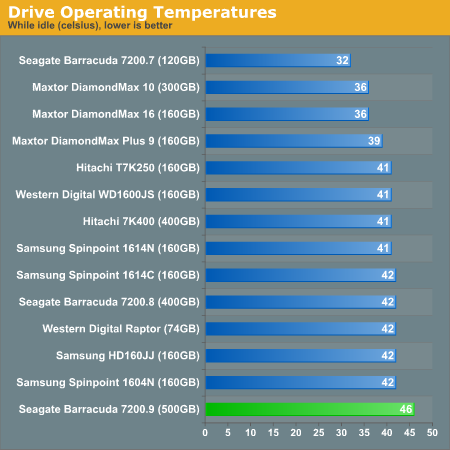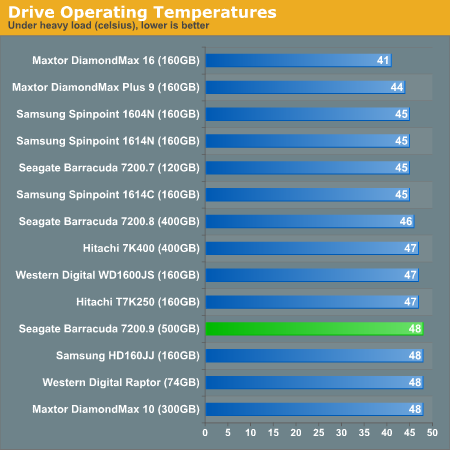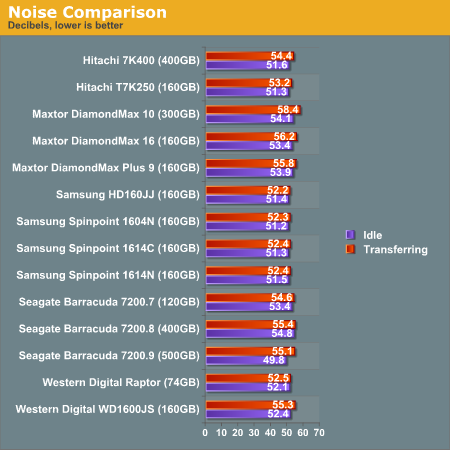Seagate 7200.9 500GB: Mouthwatering Benchmarks
by Purav Sanghani on October 24, 2005 12:05 AM EST- Posted in
- Storage
Thermal and Acoustics
Heat and sound are also two very important factors in drive performance especially when considering where they will be used. A loud hard drive that becomes warm very quickly may not be the best choice for home theater PCs or any PC without adequate cooling, and the noise alone could be a bit annoying. Take a look at how each drive performed as far as heat and noise output goes.
Thermal
Acoustics
To measure the sound output of each drive, we have taken decibel readings of each drive at their startup phase as well as the sound output while there is disk activity.
Heat and sound are also two very important factors in drive performance especially when considering where they will be used. A loud hard drive that becomes warm very quickly may not be the best choice for home theater PCs or any PC without adequate cooling, and the noise alone could be a bit annoying. Take a look at how each drive performed as far as heat and noise output goes.
Thermal


Acoustics
To measure the sound output of each drive, we have taken decibel readings of each drive at their startup phase as well as the sound output while there is disk activity.











46 Comments
View All Comments
MCSim - Monday, October 24, 2005 - link
Seems to be a very performer in multitasking situations.ElFenix - Monday, October 24, 2005 - link
seagate has had 133 GB platters for a while now. could just be the same drive stuck into a new box. the 160GB platter model is the only one that seems worth reviewing, the higher areal density should translate into better performance.johnsonx - Monday, October 24, 2005 - link
hey Seagate, why not put 4 160Gb platters into one drive? 4x160 = 720Gb, a new record capacity. If you can put 4 125's in one drive, 4 160's should be doable.Concillian - Monday, October 24, 2005 - link
First, 4x160 = 640 not 720.
Second, I bet nobody ever thought of that, you're a genious.
My guess is that there are issues with 'wobble' causing higher densities to be more challengineg in a stack of 4 than a single platter. Hitachi's 500 GB drive is 5 platters, while their smaller drives use 125GB platters. Seagate is already packing the most in the least, so to speak.
Anton74 - Monday, October 24, 2005 - link
When a gigabyte of RAM can be had for less than $90, why is it that a 16MB buffer (1/64th of 1GB) is considered generous for a hard drive? Especially for higher priced large high-end drives, why not use a substantially larger buffer, like 64 or 128MB? Wouldn't the modest price increase ($10? $30?) be well worth the additional performance?Also, with the very slow progression of hard drive performance, why is everyone stuck at 7,200 RPM (Raptors and SCSI etc. excepted of course)? Perhaps moving up to 10,000 RPM would be too expensive for now, but how about 8,000 or 8,400 RPM as the next step up? Every bit helps.
Is it technically feasible to allow simultaneous use of all drive heads, as opposed to 1 at a time?
I would think things like these would set a drive apart quite noticably in the current field of mediocricy.
On another note, what is wrong with (current implementations of) NCQ? It is easy to understand how it would not really help for relatively light (typical desktop) loads, but how can an efficient re-ordering of IO requests hurt performance like it does some of the time? Currently, it seems as if enabling NCQ simply alters the "performance profile" of a drive, gaining some of the time, and losing some of the time. Could it be that the nForce4 chipset is to blame here? Just a hunch.
How about enabling write caching? I'd be very interesting to see benchmarks showing what that can do (and yes, I realize the risk of data loss - it's called "UPS" :).
Anton
Concillian - Monday, October 24, 2005 - link
Because more wouldn't necessarily help. Where we see a delay with a hard drive is when we're loading a large amount of sequential data (like loading a level in a game or an application). These will not be in the cache anyway, nor would it be practical to have enough RAM to cache them, because it's not really predictable. Cache in a hard drive has never been proven to increase performance as far as I know. It's mostly a 'checklist' item that MFRs have to have on there because some consumers think it matters.
I think this is mostly because the market for such drives is quite small. The vast majority of drives are going into Dell/HP/Compaq computers to people who only care how many megabytes they have, and don't care about hard drive speed. Raptor is in a pretty unique market segment, and while they may be popular with the type of people who read AT, I'd be willing to bet it's one of the smallest volume drives WD makes.
There's no technical reason MFRs couldn't make 15k RPM ATA drives like they do with SCSI drives now. The question is whether it's monetarily feasible for them to do so or not. Clearly MFRs have seen the Raptor alone in the ATA @ 10k space for quite some time, and nobody else has decided to move there. I assume there are financial reasons for this, as it's definitely technically possible. As an enthusiast you just have to come to terms with the fact that you are not the market that most HD MFRs cater to.
My guess is no. I think positioning mechanisms are constantly making small adjustments to keep the head on track. It's impossible to expect more than one head in the stack to be centered on track at any given time. Keep in mind there are thousands of tracks in one inch, and the adjustments made may only be a fraction of a thousandth of an inch. One head works because it gets close, then the formatting info feeds back to the positioning mechanism to tell it 'a little to the right' or 'a little to the left' several times each rotation to keep it centered on each track. It's impossible to expect multiple surfaces to stay on track, as they would all need independent mechanisms for that fine adjustment.
I think people often have unrealistic expectations of drives. Check the gigabyte iRAM review here on AT to see what the ultimate performance could be. This review showed me that there really aren't huge performance benefits to be had through storage improvements.
hoppa - Monday, October 24, 2005 - link
"Mouth-watering benchmarks," yet you can't even recommend it?The benchmarks are good on this thing, yes, but they don't make it the best drive (which is what, 2 years old at this point?), and with new releases coming out in CPU/Video/RAM which routinely clobber the past competition, this is really kinda sad. I understand all the technology very well, and it has been clear for a while that today's model of the hard-drive won't see any real speed improvements without some major ideas, and no one is coming up with them.
-andy
thatsright - Monday, October 24, 2005 - link
How is this 'Mouthwatering?'Just another okay-average HD. The title really is misleading......
SlinkyDink - Monday, October 24, 2005 - link
on the "Application Load Times (average, seconds)" graph on the Photoshop CS benchmark:Wy is the Seagate with 8.024 highlighted instead of the Hitachi with 7.984?
yacoub - Monday, October 24, 2005 - link
Why is Anandtech like this now? How about reviewing the other capacities, especially one around 250GB that most people would tend to buy? It's getting a bit ridiculous around here with all the reviews ONLY focusing on the largest, most expensive part available. :[